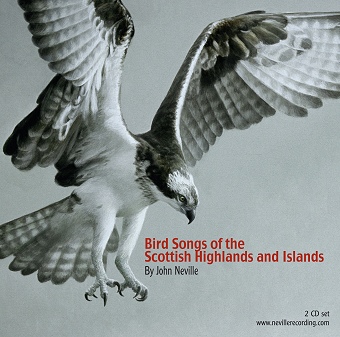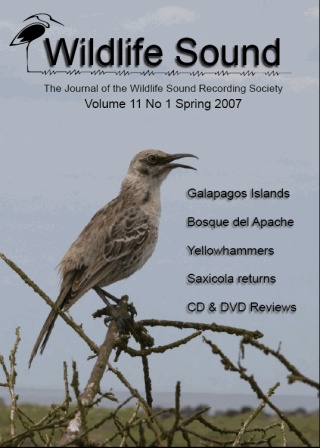
BIRD SONGS OF THE SCOTTISH
HIGHLANDS AND ISLANDS
A double audio CD album from John Neville;
cover painting by Robert Bateman
ISBN 0-9781797-1-4
Available from www.nevillerecording.com

 BIRD SONGS OF THE SCOTTISH HIGHLANDS AND ISLANDS A double audio CD album from John Neville; cover painting by Robert Bateman ISBN 0-9781797-1-4 Available from www.nevillerecording.com |

|
John Neville released his first CD in 1994 and is now a seasoned publisher. The ‘Neville Recording’
label is well established and this latest album is their eleventh title; the list includes one book, reviewed
in a previous Journal issue. However, it isnot exactly ‘business as usual’, and this album marks a new
departure. Most of John’s previous work was recorded in Western Canada, but in spring 2005, the team
crossed a few time zones for their annual expedition and toured Scotland. Although I am anglicised,
Scotland just happens to be my native land and I was quite nostalgic as I listened to John introducing
the tracks. I know the birds and the locations from previous visits, so I can write these notes with some
confidence. This ambitious album is not short on content, covering most of the Scottish breeding birds
and winter visitors. The numerous tracks feature all the important species and our favourite
songsters.Obviously, it would take a lifetime to record them all successfully and a veritable ‘mission
impossible’ for a visitor on a short tour. Accordingly John enlisted the help of British recordists, to do
justice to his title, and naturally he turned to WSRS members for the requisite recordings; our esprit de
corps lives on!
Our Journal Editor, Simon Elliott contributed themost, and other WSRS members listed in the credits
include Derek McGinn, Chris Watson and Kyle Turner. I think they can all be correctly described as
celebrity guest recordists, and in recognition of their achievements:
"This CD is dedicated to Robert Bateman and Simon Elliott. Both have contributed
enormously to our understanding and appreciation of ornithology."
John sticks to his customary format, using ‘voiceovers’ to introduce the tracks and I do find this
approach more ‘user-friendly’ than trying to follow a printed track list. The announcements are short
‘vignettes’ of the subjects, read by John in his inimical style and the balance between the parts is
about right. Most tracks are ‘dual mono’ format and a few sound like ‘reflector stereo’. The audio
quality is good throughout with the local people supplying the ‘difficult’ recordings and I am not
exaggerating when I write that many of the featured clips are the best available anywhere.
Now as we all know, Scotland is no pastoral idyll; it lies in the path of the North Atlantic weather
systems and is notorious for changeable conditions. Accordingly, we hear plenty of convincing
backgrounds of roaring surf, sea wash, running water and wind for that authentic ‘room tone’,
doubtless tamed in the studio by Traz Damji, the sound engineer. I was defeated by the elements on my
last visit and I recollect a boyhood holiday in the Hebrides when the cups blew off the anemometer!
The numerous tracks present quite an assortment of subjects. All the common species are covered,
as you would expect, and just because they are common does not mean they are unimportant. I
never tire of hearing good recordings of our favourite waders on their breeding grounds; birds
such as Curlew, Lapwing, Snipe and Golden Plover are always good value and their exciting
sounds are evocative of the moors and uplands.
Wildlife Sound Spring 2007 50
Like any other location, Scotland hosts its specialities and for obvious reasons, most of the
‘challenging’ recordings were supplied by the WSRS members already named. Nevertheless,
John made many fine recordings himself and I can mention his Barn Owls on Islay and the Wheatear
singing at Durness. The ‘grating’ Ptarmigan was particularly good, and other notables include both
breeding divers, Snipe, Arctic Terns, Fulmar and Long-tailed Duck, known as Old Squaw in North
America. Readers will know that Simon Elliott specialises in recording raptors at the nest and his ‘close
miking’ technique delivers unrivalled audio quality, not to mention new material for the science of bio-
acoustics. Good marks for both technical merit and artistic impression! Raptor species from Simon in
this album include Peregrine, Sparrowhawk, Kestrel, Buzzard, Honey Buzzard, Golden Eagle and
Osprey, plus a couple of owls. Incidentally, I have not personally heard Short-eared Owls, ‘live’ on their
breeding ground and I particularly liked the female’s husky, barking call on CD#2, Track 6. Of
course, Simon is an all-rounder and not limited to raptors and contributed many of the other
connoisseurs’ recordings, too numerous to mention individually.
Local knowledge is useful and Scotland is the ‘happy hunting ground’ of Derek McGinn, who is
resident in the Highlands. During a lengthy career, he has been able to take advantage of good
conditions and exploit the recording potential of the region. He has tracked down the elusive species
and supplied many of the ‘trophy’ recordings from the remote sites. He contributed samples of Dotterel
and Snow Bunting on the high tops and seabirds such as Gannets and Manx Shearwaters on their
inaccessible island colonies. I enjoyed his ‘rookooing’ Black Grouse at lek, and the bubbling
chorus was all the better for being in stereo. Chris Watson weighed in with rare recordings of
Razorbill, Hen Harrier and White-tailed Eagle, while Kyle Turner supplied the Vixen & cubs plus
the Pheasant roost; all handpicked samples of seriously good quality. We generally agree that routine
wildlife recordings are a bit light on bass. Our parabolas colour the sound by acting as de facto
frequency filters and further south, we feel obliged to filter our raw material to neutralise ‘Home
Counties static’ and traffic roar. So it made a refreshing change to hear the roar of the surf and some
interesting sounds in the lower register. My trusty headphones do not generate a heavy bass response,
but they are more revealing than speakers and I enjoyed tracks such as the Rock Dove (LE),
Cuckoo (JN), Shag (SE), Razorbills (CW), Gannets (DmcG) and the sonorous roaring of
Red Deer (SE). Presumably, not the audiophile’s choice, but I thought John’s Fulmars
on Handa were good guttural low frequency sounds, set against a convincing sea. We are familiar with
recordings of the noisy Grey Seal Halichoerus grypus and indeed this species is a regular target for
our microphones. Conversely, we seldom hear the Common (Harbour) Seal Phoca vitulina, one of the
quieter Pinnipeds. Admittedly, John’s sample, recorded at Port Ellen, will not impress the music lovers
among us, but it will please the naturalists and I was certainly interested to hear it. The atmospheric
whistling of the drake Wigeon is an exciting wild sound and is justifiably a popular subject, but does
the example illustrate true ‘duetting’? Listening to Simon’s recording on CD#2 Track 76, it does seem
that the timing of the drake’s glissando whistle is synchronised with the preceding purring note from
the female. I know of other British species that seem to synchronise in this way including the Long-
eared Owl and Chaffinch, but that is another story….
Territorial song is one aspect of our interest, but soundscapes change with the seasons and how
very different birds sound en masse! We hear thecacophony from the great seabird colonies and the
flocks of wildfowl and waders that animate the winter scene. Novice naturalists will learn to identify
these sounds, while old hands are transported to all those wild and exciting locations. Magic!
Congratulations are in order for another successful publication. Clearly, a lot of work has gone into this
ambitious new title, which maintains John’s usual high standard. It will certainly enhance the good
reputation of Neville Recording. The album has an intrinsic educational value, being both informative
and entertaining. It offers more than routine documentary recordings and enthusiasts will be pleased
with the quality of the rare samples. I was quite nostalgic as I listened, reminded of past adventures in
wild and remote places. So, whatever next? More globetrotting or perhaps another book?
Clearly, John is a natural raconteur and I would encourage him to continue recording and writing.
Either way, we can be sure that he will not rest on his laurels and there will be more to come from
Neville Recording. Keep up the good work!
Gordon Edgar